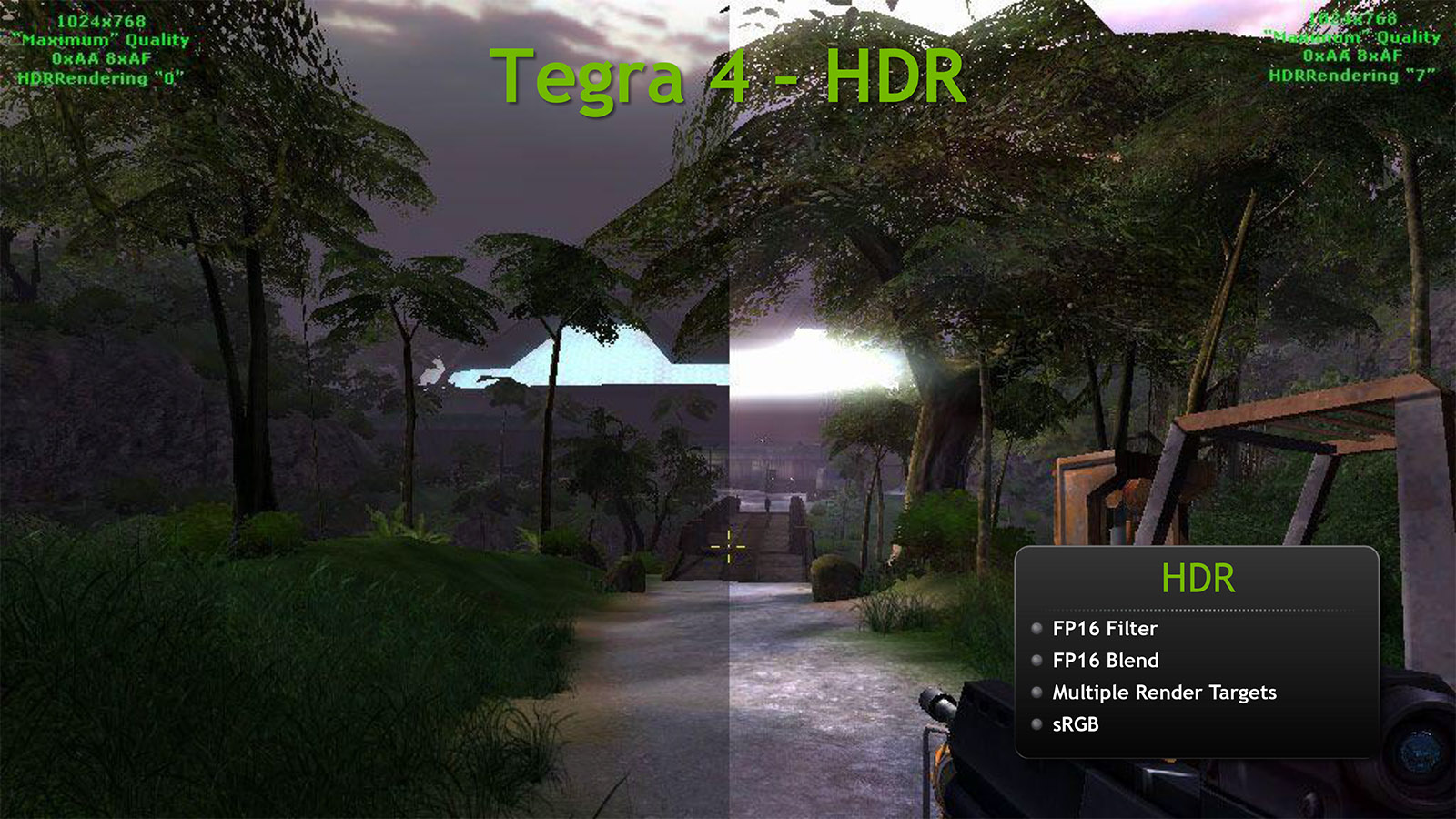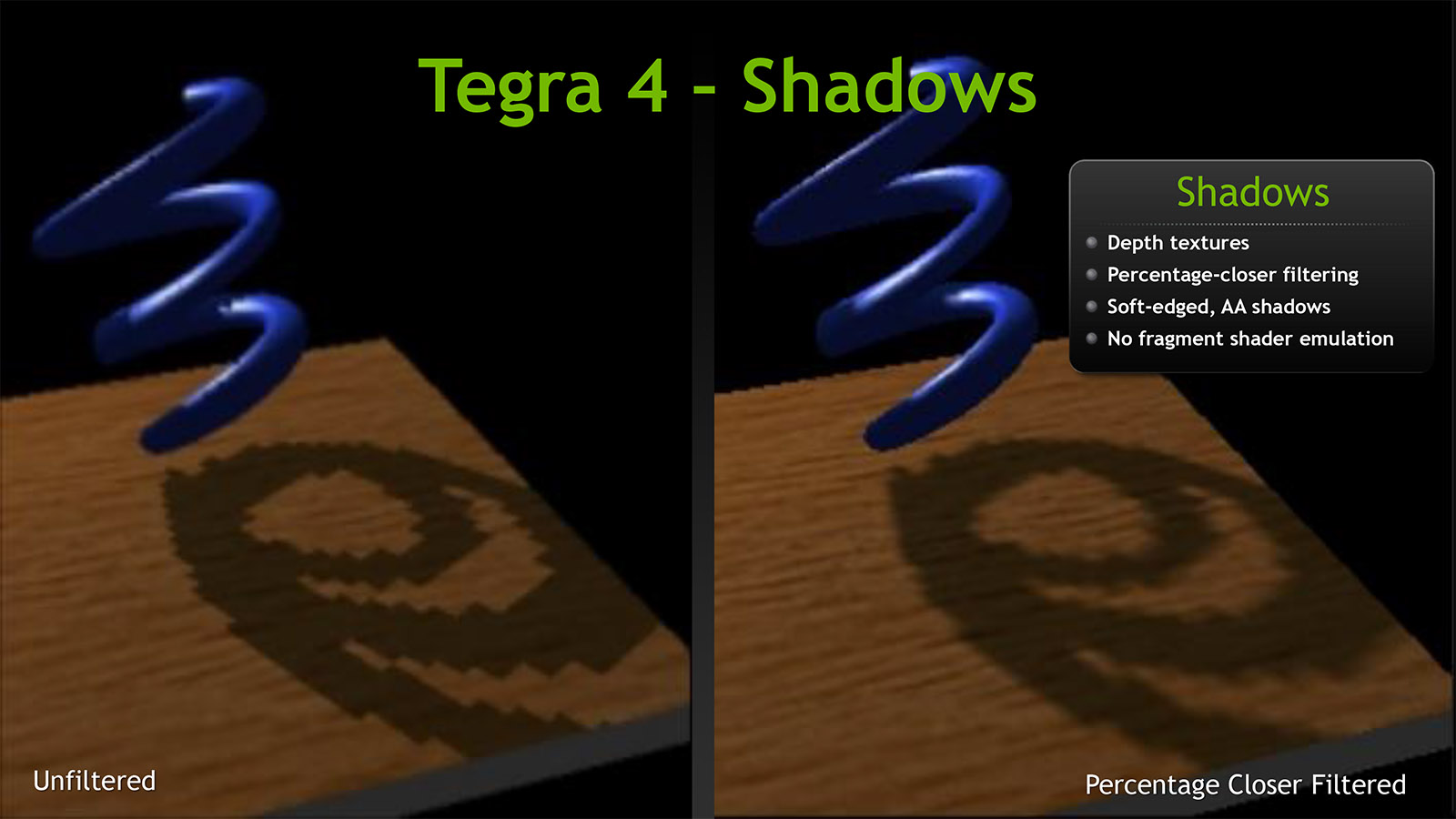Nvidia's Tegra 4 GPU: Doubling Down On Efficiency
After fending off barbs from its competition about Tegra 3's power consumption under load, Nvidia wanted to show off the architectural efficiency of Tegra 4. We sat down with the company for a deep-dive on the SoC family's unique GPU implementations.
Tegra 4 Features And Functionality
On paper, Tegra 4 is an OpenGL ES 2.0 architecture. It’s missing just a couple of capabilities that would have been required for ES 3.0 compatibility—mainly, FP32 precision (plus the formats that go along with it) and ETC2 RGB compression. Neither is significant, Nvidia argues. The precision would only be important for general-purpose computing, while Tegra 4 does support DXT compression to achieve many of the same things as ETC2.
On the DirectX side, Tegra 4’s GPU supports the Direct3D 9_1 feature level. Higher feature levels want FP32 precision in the fragment shader as well, and Nvidia’s is limited to FP20. They also want R32F format support, along with a couple of other texture formats that Tegra 4 can’t do. The company says it’s in talks with Microsoft to expose the 9_3 surface formats though, which are supported in hardware and used for HDR, without the API’s precision requirement. Until something happens there, higher-level features like instancing can’t be used under Windows RT.
Even still, Tegra 4 includes a host of new features that Nvidia believes will improve the quality of optimized games. Take anti-aliasing support as an example. Previously, Tegra 3 offered coverage sampling anti-aliasing, which calculated coverage values within a pixel. Because the value of a coverage sample depends on the pixel’s composition, however, CSAA ranges from somewhat to not at all effective. Tegra 4 solves this with full 2x and 4x multi-sample anti-aliasing support, aided by the implementation of color and Z compression.
Tegra 4 also picks up a 24-bit Z- and 8-bit stencil buffer, compared to Tegra 3’s 16-bit Z-buffer. Array textures, cube maps, and texture border color likewise make Nvidia’s list of added features.
The inclusion of depth textures and percentage closer filtering are for shadow maps, allowing high-quality shadows with filtering around the edges. Of course, it’s possible to achieve more realism with DirectX 11 and a TFLOP-class GPU. But this DirectX 9-era technique is still the way some console titles handle shadows. It’s not completely free in Tegra 4; it’s a hardware-based feature though, so you don’t have to burn shader cycles on the filtering.
Nvidia upgrades Tegra 4’s maximum texture resolution to 4K x 4K, up from Tegra 3’s 2K x 2K. In theory, that makes it possible for a game developer to use assets from a PC or console title, yielding nice high-res textures.
Beyond better-looking textures, Nvidia says there are a number of games in development with true HDR. Tegra 4 enables these with FP16 filter and blend support, MRTs, and the requisite surface formats. This was some of the most talked about functionality back in the GeForce 6800 days (remember the Far Cry 1.3 patch that added HDR support to an already gorgeous-looking game?). Now, eight years later, we’re getting a taste of it in the mobile space.
Get Tom's Hardware's best news and in-depth reviews, straight to your inbox.
Current page: Tegra 4 Features And Functionality
Prev Page Stepping Through Tegra 4 Next Page Tegra 4i: A Chip Off The Old Block-
s3anister I'm always amazed with the progress made in strides in this ultra-competitive sector so it's nice to see nvidia finally hit 28mm with Tegra 4. I'm sure some of their performance gains can be attributed to this.Reply -
levin70 Charlie at semiaccurate is correct. The Tegra 4 is DOA. Almost no one will be using it. Everyone else is already ahead of where the T4 is today, and it hasn't even launched. How many design wins were noted? 1?Reply
Yeah, says it all. -
blazorthon deedee2die4Nvidia staying on top, the best of the best!Reply
Uhh, no... T4 isn't supposed to be out for like six months, yet it's already not as fast as some of Qualcomm's latest. Nvidia is improving, but as usual, they're staying a little behind in technology. -
aicom levin70Charlie at semiaccurate is correct. The Tegra 4 is DOA. Almost no one will be using it. Everyone else is already ahead of where the T4 is today, and it hasn't even launched. How many design wins were noted? 1?Yeah, says it all.Nobody is ahead of Tegra's four Cortex A15 cores. Krait is at less performance than A15 (until the refresh at least). Samsung's got Exynos 5 Octa, but that's not out yet either and T4 will probably still top it in the GPU performance department. Speaking of which, Tegra 4 has the most powerful GPU in floating-point of anyone (including the iPad 4) with 74.8 TFLOPS @ 672 MHz. It only takes a 825 MHz Cortex A15 to match a 1.6 GHz A9, and Tegra 4 is supposed to ship at 1.9 GHz. Unfortunately, TDP does go up in the process.Reply
You also have to look at where these parts are targeted. Krait is really gunning for phone design wins and they have many. It's a very power efficient chip that found its way into some very nice phones. Tegra 4 is not aimed at that market; Tegra 4i is. Tegra 4 will have a much higher TDP than 4i (and Krait) and will get substantially higher performance as a result. -
tjosborne Hey guys, I am considering getting a Asus transformer prime tablet with the tegra 3. Would it be best to wait till this processor ends up in a tablet to get one?Reply -
So at 1.3Gpix/s, Nvidia has just admitted to 10x overdraw...per second? So we're looking at 9~10 frames per second oh high res displays. Lag lives on.Reply
-
PreferLinux aicomNobody is ahead of Tegra's four Cortex A15 cores. Krait is at less performance than A15 (until the refresh at least). Samsung's got Exynos 5 Octa, but that's not out yet either and T4 will probably still top it in the GPU performance department. Speaking of which, Tegra 4 has the most powerful GPU in floating-point of anyone (including the iPad 4) with 74.8 TFLOPS @ 672 MHz. It only takes a 825 MHz Cortex A15 to match a 1.6 GHz A9, and Tegra 4 is supposed to ship at 1.9 GHz. Unfortunately, TDP does go up in the process.You also have to look at where these parts are targeted. Krait is really gunning for phone design wins and they have many. It's a very power efficient chip that found its way into some very nice phones. Tegra 4 is not aimed at that market; Tegra 4i is. Tegra 4 will have a much higher TDP than 4i (and Krait) and will get substantially higher performance as a result.You mean Gigaflops, not Teraflops.Reply -
blazorthon aicomNobody is ahead of Tegra's four Cortex A15 cores. Krait is at less performance than A15 (until the refresh at least). Samsung's got Exynos 5 Octa, but that's not out yet either and T4 will probably still top it in the GPU performance department. Speaking of which, Tegra 4 has the most powerful GPU in floating-point of anyone (including the iPad 4) with 74.8 TFLOPS @ 672 MHz. It only takes a 825 MHz Cortex A15 to match a 1.6 GHz A9, and Tegra 4 is supposed to ship at 1.9 GHz. Unfortunately, TDP does go up in the process.You also have to look at where these parts are targeted. Krait is really gunning for phone design wins and they have many. It's a very power efficient chip that found its way into some very nice phones. Tegra 4 is not aimed at that market; Tegra 4i is. Tegra 4 will have a much higher TDP than 4i (and Krait) and will get substantially higher performance as a result.Reply
S4 Pro is a faster CPU IIRC. IDK about how the graphics compares and won't comment about it.
Nvidia, like I said, is getting better, but they're still going to be a little behind. They're making up a lot of ground here, especially with how they're making Tegra 4 and Tegra 4i instead of a single SoC to take both places, but they seem like they'l still have a little room to make up, at least in CPU performance, to be the best. Like I said before (at least in other articles about it), they'll still be near the top either way.


